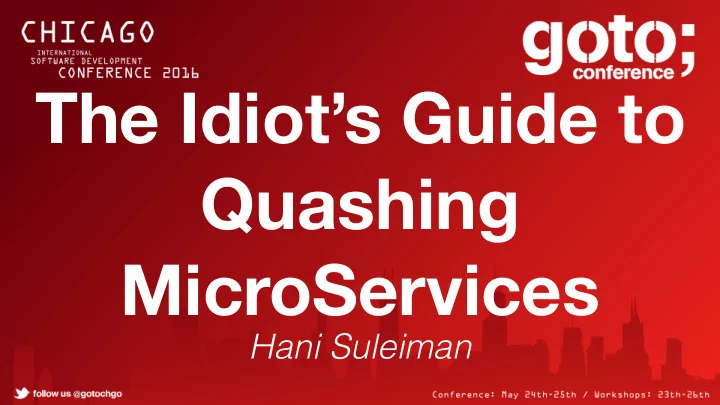

The Idiot’s Guide to Quashing MicroServices Hani Suleiman
➤ The Promised Land ➤ Welcome to Reality ➤ Logging ➤ HA/DR ➤ Monitoring ➤ Provisioning ➤ Security ➤ Debugging ➤ Enterprise frameworks ➤ Don’t Panic
WHOAMI ➤ I wrote a book about testing ➤ It’s pretty irrelevant for this talk, but buy it anyway ➤ I had a blog ➤ It had very many bad words, do not look it up ➤ CTO ➤ But not anymore ➤ T witter @bileblog
WHOAMI ➤ What makes me an expert? ➤ I’m not ➤ I’ve screwed this up many times so you don't have to ➤ I work with big banks
AN AWKWARD CONVERSATION Yes, this really happened. The following movie is basely on real life events at a very large investment bank. I was one of the people getting shouted at. https://youtu.be/Q65Q1Mi5Jtw
TL;DR ➤ If you hate microservices, use these points to ensure you never have to use them ➤ If you love microservices, make sure you have sensible answers to these points before suggesting adoption
THE PROMISED LAND ➤ Infinite linear scalability ➤ Well defined contracts ➤ Unix philosophy (do one thing well and play nice with others) ➤ Faster releases ➤ Team scalability ➤ ‘Everything fits in your head’
WELCOME TO REALITY ➤ Something went wrong, where do I look? ➤ How do I reproduce an error? ➤ The unix analogy is crap ➤ The audit guys found out we’re using unauthenticated http between services. They are first sad, then angry ➤ I’m only allowed to use our enterprise DB for storage ➤ I need a new server and I’m told if all goes well it’ll be here in 2 months, then another 2 to get it production ready
LOGGING ➤ Many services logging to di ff erent files ➤ How do we correlate logs? ➤ Where do I start looking?
LOGGING ➤ You should never need to log in a server to view logs ➤ You must aggregate ➤ Logs must be semi-structured ➤ Consider ELK stack if you’re poor, Splunk if you have budget
HIGH AVAILABILITY / DISASTER RECOVERY
HIGH AVAILABILITY/DISASTER RECOVERY ➤ Di ff ering SLAs across services ➤ Di ff erent loads ➤ Trade o ff between scalability and performance
HIGH AVAILABILITY/DISASTER RECOVERY ➤ You probably need a service locator. Sorry ➤ Consul ➤ Zookeeper ➤ etcd ➤ State is the root of all evil ➤ Use a modern distributed messaging system like Kafka ➤ Consumers pick their own rates ➤ Recovery from a point in time ➤ Easy replay
MONITORING
MONITORING ➤ Many more processes to keep track of now ➤ Knock-on impact of related services ➤ Multiple SLAs ➤ Proactive vs reactive
MONITORING ➤ Need both aggregate and drill down views ➤ Once a minute is not enough ➤ Correlation with logs ➤ Historic, not just point in time
PROVISIONING
PROVISIONING ➤ Too many services to rely on manual deployment unless you have a meat cloud. ➤ Complex interactions/orchestration ➤ Di ff erent deployment profiles ➤ Deploy just this service ➤ Deploy these related services ➤ Deploy the world
PROVISIONING ➤ Agile hardware moves from nice to have to must have ➤ Decouple configuration from application ➤ Use a configuration management solution ➤ Puppet ➤ Chef ➤ Ansible ➤ Do not roll your own
SECURITY
SECURITY ➤ I have to worry about security IN my application now?! ➤ Multiple data stores ➤ I’ve gone polyglot, and now I need to learn about security across so very many frameworks and libraries ➤ That’s ok, I can just google for best practices ➤ Not so much
SECURITY ➤ Principal propagation ➤ Service authorization/authentication ➤ Secure communications ➤ Logging and monitoring, again
DEBUGGING
FAILURE MODES ➤ What happens if a service is down? ➤ Local caches for lookups ➤ Use queues for fire and forget services ➤ What happens if a service is slow? ➤ Your awesome proactive monitoring will alert you ➤ What happens if I have ‘at-least-once’ semantics? ➤ Make your services idempotent ➤ What happens if a service is wrong? ➤ You’re screwed
DEBUGGING ➤ Debugging a distributed system is stupidly di ffi cult ➤ T wo services both think they’re right, together they’re wrong ➤ Fatal failures are awesome ➤ Non-fatal failures need tooling to reproduce state ➤ Journal of state events needed to get us to the bad state ➤ Dynamic instrumentation to interrogate a naughty service
ENTERPRISE FRAMEWORKS
ENTERPRISE FRAMEWORKS ➤ Enterprises love frameworks but individuals love libraries, guess who wins? ➤ Frameworks impose constraints on your service ➤ You must use JMS and MQSeries ➤ You must use Oracle ➤ Domain objects must be modeled by our modeling czar ➤ API contracts must be approved by the Subcommittee for API Contract Approvals ➤ ‘Insert business logic here’ ➤ Too easy to fall into shared state
DON’T PANIC ➤ You don’t need all this stu ff to get started ➤ You do need to keep it in mind and be able to make sensible noises when asked ➤ Most of these concerns are orthogonal, di ff erent teams can work on them in parallel ➤ There are frameworks that simplify some of these things (Kubernetes and friends)
Recommend
More recommend